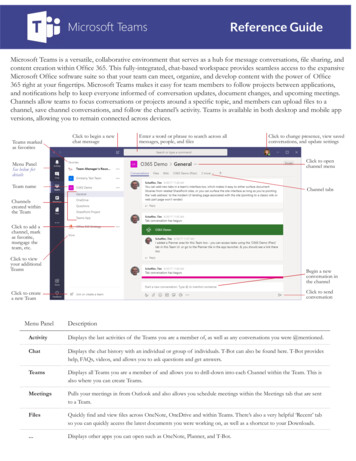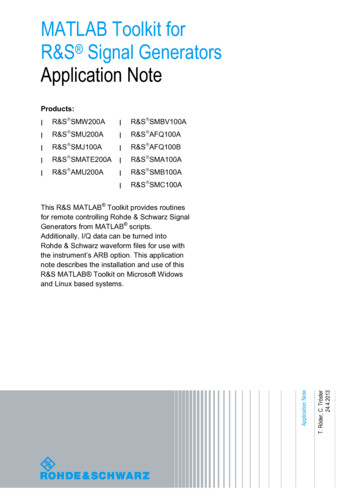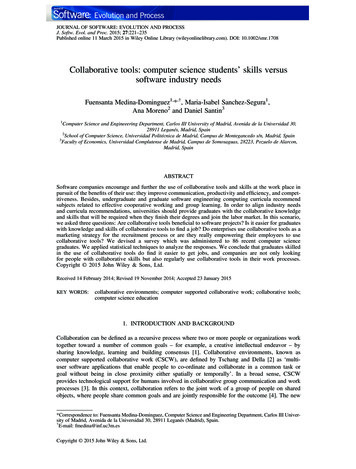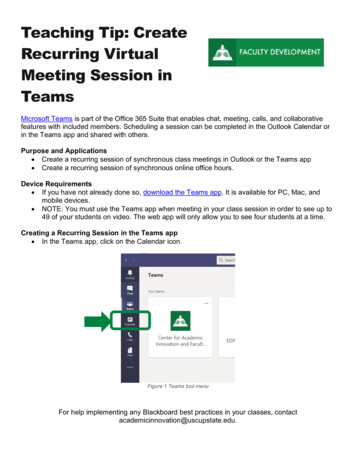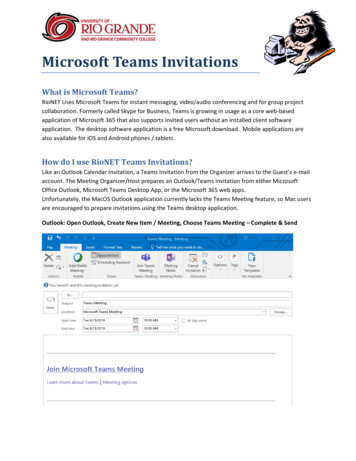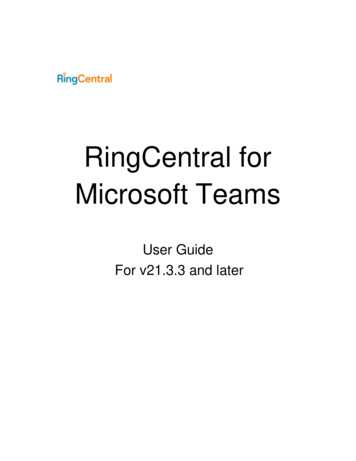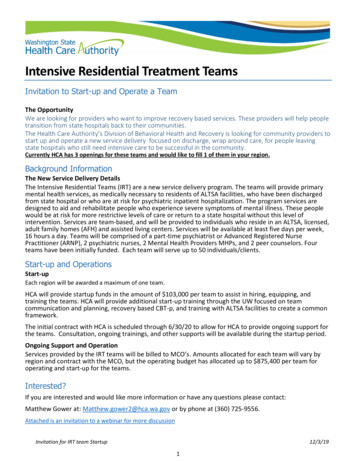
Transcription
Collaborative Teams ToolkitTools to support collaborative team structuresand evidence-based conversations in schoolsOffice of EvaluationFall 2015State of New JerseyDepartment of EducationNew Jersey Department of Education, 1
ContentsPart 1: Introduction . 3About this Toolkit . 3The Tools . 3How to Use this Toolkit . 4Part 2: The Self-Assessment . 5Part 3: Foundational Level: Establishing and Supporting Collaborative Teams . 10Strategy 1.1: Time for Collaboration . 10Strategy 1.2: Adequate Materials and Supplies . 11Strategy 1.3: Clearly Articulated Roles and Responsibilities . 12Strategy 1.4: Building Consensus Around Vision and Goals . 12Part 4: Advanced Level: Alignment, Integration and Relevance . 19Strategy 2.1: Mechanisms in Place for Making Effective Data-Driven Decisions . 19Strategy 2.2: Instructional Expertise to Guide Improvement . 23Strategy 2.3: Engaging in Practices for Continuous Improvement . 23Strategy 2.4: Alignment with Key Instructional Deadlines and Activities . 26New Jersey Department of Education, 2
Part 1: IntroductionAbout this ToolkitThe Collaborative Teams Toolkit is intended to help schools establish productive collaborative teamsof teachers and administrators working and learning together to help their students. This toolkitfocuses on supporting the monitoring of Student Growth Objectives (SGOs) and other student data byproviding the necessary tools to promote the environment for having successful evidence-basedconversations. This toolkit is built following New Jersey's Standards for Professional Learning. Pleasevisit the AchieveNJ website for updates to this resource, as well as other tools and resources tosupport SGO implementation and many other elements of AchieveNJ.Three New Jersey school districts collaborated with the New Jersey Department of Education (“theDepartment”) and the United States Department of Education (USED) in the creation of this toolkit.Over the course of spring 2015, teachers, principals, central office staff, and superintendents fromthese three districts met together virtually and in person to discuss SGOs and collaborative teamingin their districts, what they have tried, and what has been effective. The Department’s Office ofEvaluation looked nationally at best practices in both developing and supporting collaborative teamsand with feedback from the three districts, compiled the resources, and developed new tools thatcomprise the current toolkit. In addition, the Department sought feedback and insights from theAchieveNJ Advisory Committee. Every piece has been thought through by New Jersey educators, withNew Jersey educators in mind.The ToolsAcknowledging that schools will be at many different starting points for this work, the tools span alllevels of needs and are divided into two types. The first set, Foundational Level: "Establishing andSupporting Collaborative Teams” contains foundational level tools and resources aimed at laying thegroundwork for successful collaborative teams. The second set, Advanced Level: “TakingCollaborative Teams to the Next Level: Alignment, Integration, and Relevance” are more advancedand are designed to help schools consistently engage in the most productive evidence-basedconversations. Each set of tools links to various other documents and resources to help you alongthe path of sustaining high functioning teams in your school or district. The chart lists the contentwithin the kit.Collaborative Teams ToolkitFoundational Level:Establishing and Supporting Collaborative Teams1.2.3.4.5.Self-AssessmentTime for CollaborationAdequate Materials and SuppliesClearly Articulated Roles and ResponsibilitiesBuilding Consensus Around Vision and GoalsAdvanced Level:Alignment, Integration, and Relevance1. Self-Assessment2. Mechanisms in Place for Making EffectiveData-Driven Decisions3. Instructional Expertise to Guide Improvement4. Engaging in Practices for ContinuousImprovement5. Alignment with Key Instructional Deadlinesand ActivitiesNew Jersey Department of Education, 3
How to Use this ToolkitSchools can begin using this toolkit by completing the self-assessment, found on page 6. This shouldbe completed by a school principal or other district leader along with a school leadership team (suchas the School Improvement Panel) and can be an integral part of a school or district levelprofessional development plan. The self-assessment will help in identifying strengths and areas ofgrowth. Below each component is a resource section with links to various materials and tools to helpguide you through the steps in meeting your goal(s). Each of these links is accompanied by a briefdescription of the resource. These will guide you towards strengthening that individual area of thecollaborative team process. Steps for completing the self-assessment are listed below.Note: The associated tools contained within the guidebook are intended to support schools along acontinuum of collaborative team implementation, and are intended to be flexible and adaptable toyour individual school and staff’s needs. There is no one perfect order, and, depending on yourspecific context, only parts of an individual tool or activity will be relevant to your school or yourteam.Whether you are in the early stages of this work or in need of improvement (foundational), or haveestablished teams ready to go to the next level (advanced), certain items must be present to workeffectively. The following chart describes the typical school as it moves across the continuum offoundational level teams through advanced. The different levels of implementation (foundational andadvanced) and their descriptions and components are listed below.FoundationalAdvancedSchool needs assistance puttingsolid collaborative team into place.Or if they are in place, making them School has well-establishedcollaborative teams and can usefunctional bodies in promotingsupport to be even more effective.student achievement. Time for Collaboration Adequate Materials and Supplies Clearly Articulated Roles and Responsibilitieswithin Teams Building Concensus Around Vision and Goals Mechanisms for Making Effective Data-drivenDecisions Instructional Expertise to Guide Improvement Engaging in Practices for ContinuousImprovement Alignment with Key Instructional Deadlinesand ActivitiesFoundational level tools largely address structures for putting the proper foundations in place forcollaborative teams to exist and function. 1.1: Time for Collaboration: tools and resources for making the most of your schedule forcollaborative team structures 1.2: Adequate Materials and Supplies: tools and resources checklist to supplementcollaborative teamwork (including having access to proper data) 1.3: Clearly Articulated Roles and Responsibilities: tools and resources for assigning roles,facilitating meetings, and setting protocols for doing collaborative work 1.4: Building Consensus Around Vision and Goals: tools and resources for forming normsand protocols around the group’s vision and outcomes.New Jersey Department of Education, 4
Advanced level tools are meant for well-established collaborative team structures looking to havemore advanced evidence-based conversations. 2.1: Mechanisms for Making Effective Data-Driven Decisions: tools and resources to assist inadvanced decision-making protocols and data-driven decisions 2.2: Instructional Expertise to Guide Improvement: tools and resources to assist in leadersand teachers in assessment literacy, evidence-based conversations, and developing StudentGrowth Objectives 2.3: Engaging in Practices for Continuous Improvement: tools and resources to assist inhaving evidence-based conversations and in maintaining continuous, ongoing cycles ofimprovement 2.4: Alignment with Key Instructional Deadlines and Activities: higher level district resourcesfor planning out a yearly calendar as well as integrating both mandatory and discretionaryinitiativesPart 2: The Self-AssessmentThe following are suggested steps for one way to complete this self-assessment. Depending on yourschool/district size, leadership team, etc. this process should be modified to meet your individualneeds. Step 1: Principal reviews the document for scope and relevance to the school and identifieswho should complete the self-assessment. The School Improvement Panel (ScIP) or otherleadership team should lead the process (if the ScIP includes only one teacher, schoolsshould consider consulting additional teachers representing different grade levels/subjectareas). The team should come to an understanding of what a “four” looks like at each level,along with any challenges or impediments that might exist for the school to reach that level. Step 2: Complete the self-assessment, examining your school’s strengths and possible areasof growth. Compare scores, discussing any significant differences which may exist. Decide ifadditional feedback from teachers or other building staff might add value. Step 3: Decide which components are most relevant to the school’s particular goals.Narrow down the area(s) for focus for the current (or upcoming) school year. Share results ofthe self-assessment and discuss any differences in perspectives between team andleadership team. Step 4: Define next action steps required to implement your school’s goals. Beginning withthe end in mind, discuss what people think it would take to accomplish your goals (includingperceived challenges or impediments). Identify next steps and create an action plan to buildcapacity along selected domains and components of the self-assessment tool. Communicateto all staff about the priorities and work that the school will undertake to launch, expand, orstrengthen collaborative teams for the current and/or upcoming school year.New Jersey Department of Education, 5
The Self-Assessment1. FOUNDATIONAL LEVEL: ESTABLISHING AND SUPPORTING COLLABORATIVE TEAMS1.1 Time for Collaboration432Staff have regularStaff have collaborativeStaff have collaborativecollaborative planningplanning time occasionallyplanning time infrequentlytime daily or weekly, built (monthly or less) over the(PD days) or outside of thein as part of the schoolcourse of the school year.school day.schedule.ResourcesSee Section 1.1: Scheduling Collaborative Team Time at Your School1RATINGStaff do not havecollaborative planning time.Next Steps1.2 Adequate Materials and Resources (content standards, curriculum resources, assessment materials, meeting space, etc.).432Collaborative teams haveaccess to all necessarymaterials and resources.Collaborative teams haveaccess to some materialsand/or resources and knowhow to request additionalfrom the school.Collaborative teams haveaccess to some materialsand/or resources but do nothave a way to requestadditional from the school.1RATINGCollaborative teams do nothave access to anynecessary materials orresources.ResourcesIn addition to Section 1.2, see:Common Core State StandardsNJ Core Curriculum Content StandardsPartnership for the Assessment of Readiness for College and Career (PARCC)AchieveNJNJ Model CurriculumYour school’s curriculum and curricular resourcesNext StepsNew Jersey Department of Education, 6
1.3 Clearly Articulated Roles and Responsibilities (team leader, facilitator, note-taker) Within Teams43Collaborative teams have aclearly establishedstructure with definedfunctions, and staff playthese roles effectively.Collaborative teams have aclearly established structurewith defined functions, butstaff does not participateand/or fulfill these rolesconsistently.2Collaborative team membershave informal roles andexpectations are unclear forhow staff should participate orfulfill these roles.1RATINGCollaborative teammembers do not haveclearly defined roles.ResourcesSee Section 1.3Next Steps1.4 Building Consensus Around Vision and Goals4321All participating staff havea shared vision for howcollaboration supportsimproved instructionalpractice and can articulatea set of clear learning goalsthat will help them achievethis vision.ResourcesSee Section 1.4Most participating staff havea shared vision for howcollaboration supportsimproved instructionalpractice but less canarticulate a set of clearlearning goals that will helpthem achieve this vision.Less than half of participatingstaff have a shared vision ofhow collaboration supportsimproved instructional practice,and there is little consensusaround how this visiontranslates into learning goals.There is little to noshared vision of howcollaboration supportsimproved instructionalpractice.RATINGNext StepsNew Jersey Department of Education, 7
2. ADVANCED LEVEL: ALIGNMENT, INTEGRATION AND RELEVANCE2.1 Mechanisms in Place for Making Effective Data-driven Decisions4Teams have necessarycompetencies and tools forleading productive meetingsand facilitating effectivedata-driven discussions thatresult in clear actions forimprovement.ResourcesSee Section 2.132Teams have some competenciesand tools for leading productivemeetings and facilitating effectivedata-driven discussions that resultin clear actions for improvement,but require additional training.Teams have receivedguidance for facilitatingeffective data-drivendiscussions but requireadditionalguidance/tools inimplementation.1RATINGTeams are notknowledgeable orprepared forfacilitating effectivedata-drivendiscussions.Next Steps2.2 Instructional Expertise to Guide Improvement (i.e. experts within the school community who can help unpack the standards; subjectarea specialists to deepen content knowledge; and assessment specialists to support reliability and validity)43School has dedicatedSchool has someinstructional expertise toinstructional expertise onguide teams in developingstaff to guide teams inimprovement strategies fordeveloping improvementstudents, includingstrategies for students andassessment specialists whowho can provide somecan help teachers createassistance to teachers inhigh-quality SGOcreating high-quality SGOassessments.assessments.ResourcesIn addition to Section 2.2, see:Assessment Design ModuleAssessment Design ToolkitSGO 2.1 Training and Guidebook21School has limitedinstructional expertise toguide teams in developingimprovement strategies forstudents, with limitedresources for providingassistance to teachers indeveloping high-quality SGOassessments.School has no dedicatedinstructional expertise toguide teams indeveloping improvementstrategies for studentsor to help teachersdesign high-quality SGOassessments.RATINGNext StepsNew Jersey Department of Education, 8
2.3 Engaging in Practices for Continuous Improvement (gathering evidence of current levels of student learning; developing strategiesand ideas to build on strengths and address weaknesses in that learning; implementing those strategies and ideas; analyzing the impactof the changes to discover what was effective; applying new knowledge in the next cycle of continuous improvement)4321Teams regularly review andanalyze student data frommultiple sources (daily, weekly,monthly) to drive targetedimprovements in instructionalpractice on an individual basisand school-wide and arealways engaged in the processof continuous improvement.ResourcesIn addition to Section 2.3, see:SGO 2.1 Training and GuidebookTeams infrequently reviewand analyze student datafrom multiple sources (lessthan monthly) but still attemptto use what they have to driveimprovements in practice andare sometimes engaged in theprocess of continuousimprovement.Teams rarely orinconsistently review oranalyze student data,employing it on a summativebasis (looking backwards)rather than formative, andare working towards aprocess for continuousimprovement.Teams do not reviewor analyze studentdata at all and arerarely engaged in aprocess ofcontinuousimprovement.RATINGNext Steps2.4 Alignment with Key Instructional Deadlines and Activities43Content, data analysis, andimprovement discussions inteam meetings are highlyrelevant to the instructionalplanning and improvementcycle for all educators.Content, data analysis, andimprovement discussionsin team meetings are highlyrelevant to the instructionalimprovement cycle forsome educators (i.e. corecontent areas).2Content, data analysis, andimprovement discussions inteam meetings are relevantto the instructionalimprovement cycle for asmall group of educators inthe school (i.e. teachers oftested grades/subjects).1RATINGContent, data analysis,and improvementdiscussions in teammeetings are not relevantto the instructionalimprovement cycle forany educators.ResourcesIn addition to Section 2.4, see:NJDOE School and Professional Development Planning Requirements and TemplatesNext StepsNew Jersey Department of Education, 9
Part 3: Foundational Level: Establishing and Supporting Collaborative TeamsThis selection of tools and resources is intended to help you lay the groundwork for successfulcollaborative teams in your school or district. Many of these contain links to other external tools andresources which can be used for this purpose.Strategy 1.1: Time for CollaborationScheduling Collaborative Team Time at Your SchoolIf you have minimal time for teachers to meet in teams or minimal organization of what those teamslook like, there are two issues that you must resolve in order to get started. This resource is designedto help you think through these two issues:1. Organize STAFF into teams.2. Find TIME for teams to meet and collaborate.STAFFPLANNING QUESTIONSRESOURCESHow does it make sense to organize teachersApproach #1: Grade-Level Teams or Departmentinto teams at your school? By grade level,Teams:content area, or department (Approach #1)? Or, Sample Elementary Schedulesby students taught (Approach #2)?o Marzano Sample Schedule [PDF]ADVICE:o All Things PLC Sample Schedule [PDF] Sample Middle School Schedules Have staff plan across school teams.o North Carolina Sample Schedule [PDF] Define teams by students taught or contento Virginia Middle School Double Blockcovered. Ideally, staff will have timeProposal [PDF]throughout the year to work with both SampleHigh School Scheduleshorizontal and vertical teams (e.g., weekly inoNorthCarolina Sample Schedule [PDF]grade-level teams, once a month work byoPiedmontHigh School Sample Scheduledepartment). Staff can then discuss students[PDF]in common and their instructionalo Watchung Hills Sample Schedule [PDF]approaches. Consider teams as student advisors,responsible for all aspects of the students’experience at your school.Which staff members do not “fit” into teams?Approach: Teams of Specials Teachers:ADVICE: Teams made of "specials" teacherso All Things PLC Guidance [PDF] Group “singleton” teachers (one teacher ofany given grade/subject, like one choruso James Madison University Elementaryteacher or one French teacher) with the teamGuidance [PDF]with whom they share common planning time,the team with whom they share students, orrelevant subject areas (e.g., all worldlanguage teachers). Singleton teachers can also be connectedacross schools either in person or withtechnology (e.g. all middle school Spanishteachers in the district).New Jersey Department of Education, 10
TIMEPLANNING QUESTIONSRESOURCESWhat common time do you have now, and is thatApproach: Change the Existing Schedule:time flexible? Do your teachers participate in any Sample Elementary Schedulesother common meetings? If so, how was timeo Marzano Sample Schedule [PDF]found for those meetings?o All Things PLC Sample Schedule [PDF]ADVICE: Sample Middle School Scheduleso North Carolina Sample Schedule [PDF] Assess your current meetings schedule and theo Virginia Middle School Double Blockeffectiveness of those meetings honestly.Proposal [PDF] Prioritize collaborative team meetings over Sample High School Schedulesother meetings/activities. This may meano North Carolina Sample Schedule [PDF]stopping other activities or changing the wayo Piedmont High School Sampleyou have been operating.Schedule [PDF]o Some schools have re-purposed their facultyoWatchung Hills Sample Schedule [PDF]meeting time by eliminating agenda itemsthat can be handled through email.o Some schools have given up certain facultyactivities to make time for team meetings.What does your collective bargaining agreementApproach: Flex the Schedule within Contractsay about time and your school day? What are the Parameters:parameters you will need to work within related to Sample Block Schedulestime?o Thomas Jefferson High School SampleADVICE:Schedule [PDF]o Virginia Middle School Double Block Clarify your understanding of where you do orProposal [PDF]do not have flexibility.oPiedmont High School Sample Look for windows of time within and outside ofSchedule [PDF]your school day to facilitate time for teams. Sample Rotating Drop Scheduleso Watchung Hills Sample Schedule [PDF]o University of Cal Berkley Samples [PDF] Sample Schedules Using ShortenedPeriods and Before or After School Timeo Rockwood High School GuidanceDocument [PDF]o Carmel High School Sample [PDF]o Auburn School District Samples [PDF]Strategy 1.2: Adequate Materials and SuppliesThe monitoring, prioritizing, and coordinating of resources is critical for educators to learn about theirstudent’s needs. This is especially critical to those who are new to a school, grade level team,supervisory role, or to teaching in general. Having access to the district’s curriculum, tools to collectdata, forms for turning in items such as SGOs, or any available professional development is critical toevery individual educator and the team’s success.Additional Resources from Self-Assessment Common Core: The Department’s Common Core home page NJ Core Curriculum Content Standards: New Jersey Core Curriculum Content Standards page PARCC: New Jersey’s PARCC homepage AchieveNJ: The AchieveNJ evaluation home page NJ Model Curriculum: The homepage of New Jersey’s model curriculum Your school’s curriculum and curricular resources: All of your district’s available resourcesNew Jersey Department of Education, 11
Strategy 1.3: Clearly Articulated Roles and ResponsibilitiesThe Importance of RolesSetting roles for a collaborative team can help them to run more smoothly by ensuring that certainresponsibilities are taken care of by different team members. Consider the following whendetermining roles for collaborative teams.1. Roles need not be the same for every team. Depending on the size, structure, and purpose ofthe team, different combinations of roles may be necessary, while others are not.2. Roles should be filled by those who make the most sense for the team structure. Having anadministrator or team leader facilitating a meeting could make sense for some teams, but forothers it might be more efficient to have a facilitator who is not otherwise directing the work.3. Roles can be especially important for teams that meet less often or that divide up tasks to beworked on independently.Choosing Appropriate Roles for a TeamCommon Roles and Descriptions Common role descriptions and introductory activities can be accessed from the following links: Facilitator Role [PDF] Team Roles and Descriptions [PDF]Suggestions Have a conversation about the pros and cons of using different roles. Teams may want to startby using only the most critical roles – facilitator and note taker – with administrators or teamleaders likely taking on the most essential roles. The team decides together who will take on each role. The team may assign more roles in order to spread out the responsibilities. Roles may rotate through different team members.Strategy 1.4: Building Consensus Around Vision and GoalsFoundational Protocols and Norms for Collaborative TeamsProtocols are procedures that help teams function better and meet their goals. The toolkit dividesprotocols into two levels: foundational and advanced. Foundational level activities which assist inbuilding high-functioning teams in schools can be broken down into three categories and for each ofthese categories, there are protocols that can help teams work well. The three categories are:1. Getting Buy-in2. Goal-Setting and Reflection3. Setting NormsThe following boxes provide a description of each of these categories and protocols that can helpyour team complete them. Note: Many of the categories contain multiple protocols around similaractivities. Schools should only use those protocols which best match what they need to complete aswell as what works best with their current reality.New Jersey Department of Education, 12
1. Getting Buy-InBefore implementing new procedures, especially in an existing team, it is important to get buy-in fromall team members. The following suggestions and tools can facilitate the process by helpingparticipants identify differences in communication styles and potential obstacles or sources of conflict.First, discuss what protocols are and why they are helpful in problem-solving. Then: Discuss the purpose and vision of the team; Involve all team members in identifying specific problems, making them easier to solve; and Discuss the challenges of the work and team structure that may be addressed using protocols.Protocols for Getting Buy-in:Zones of Comfort, Risk and Danger: Constructing Your Zone MapPurpose Newly established teams - get to know one another’s comfort levels for tough conversations. Existing team - learn about one another in the case of a poorly performing team.Requirements Printed “zones of comfort” for team to write on (could be completed prior to meeting).Compass Points: An Exercise in Understanding Preference in Group WorkPurpose Understand how preferred working styles may affect group work, either while setting up anew team, or to reset a team that is performing poorly.Requirements A room set up with space for four teams to meet in different parts of the room. Printed sheets with questions to answer for all participants and/or whiteboard/chart paperspace on which to write answers.New Jersey Department of Education, 13
2. Goal Setting and ReflectionSuccessful collaborative teams are able to not only identify their goals over the course of a givenschool year (and beyond), they also have processes in place for reviewing and reflecting on their goalsat key intervals, making necessary adjustments both in real time and in longer-term (annual/bi-annual)discussions. The resources included here provide some examples of how teams might begin toimplement an effective cycle of goal-setting, monitoring and reflection.Protocols for Goal Setting and Reflection:Team SMART Goal Setting PlanPurpose A foundational goal-setting tool used to assess the team’s starting point, and given thatstarting point, guidance for how to set good goals and figure out how to achieve them.Requirements Sample SMART Goals: A sample of goals set through the process above.Support for Advanced Goal SettingPurpose A goal-setting process that uses data driven cycles to support collaborative teamwork.Requirements A facilitator and team assembled to do this work.Goal Setting ProtocolPurpose To be used early in the year (or at the end of the previous year) to set agendas for the year’scollaborative team meetings and other goals for teaching.Requirements A facilitator and team assembled to do this work.Work Plan ToolPurpose Utilizing a backwards-design process, this protocol aids in both goal-setting as well asmeasuring progress.Requirements A team with access to relevant school and/or district data depending on the goal and progressbeing measured.PLC WorksheetPurpose A template to assist in planning projects related to student learning outcomes, with objectives,and how the outcomes will be measured.Requirements A facilitator and team assembled to do this work.End of Year PLC ReportPurpose A template for an end of year look back at projects/activities and their outcomes.Requirements A facilitator and team assembled to do this work.New Jersey Department of Education, 14
3. Meeting NormsMeeting norms are a shared set of ground rules or basic codes of conduct for behavior duringcollaborative team sessions. In established, highly functioning teams, norms are often implicit. Butparticularly for newly formed or struggling teams, developing a shared set of explicit norms canincrease productivity by establishing the proper tone of professionalism and collaboration.Examples of Norms; Seven Norms of CollaborationPurpose These documents contain examples of norms that can be adopted as-is or modified.Requirements An agreement among team members to choose their norms of behavior and an agreement toabide by them.Forming Ground RulesPurpose To understand the process for setting norms at collaborative team meetings.Requirements A method for capturing the group’s ground rules in a place where the whole group can seethe
Collaborative Teams Toolkit Tools to support collaborative team structures and evidence-based conversations in schools Office of Evaluation Fall 2015 . of teachers and administrators working and learning together to help their students. This toolkit focuses on supporting the monitoring of Student Growth Objectives (SGOs) and other student .
